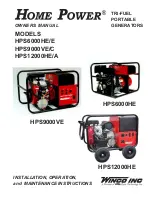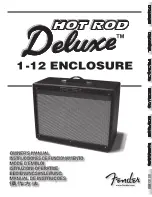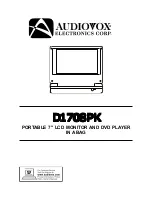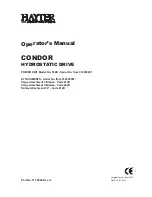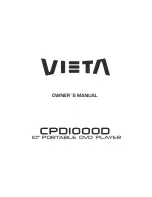
Page 3
60707-117
8199-00
The figures given above are for an average load such as a
blower or fan. If the electric motor is connected to a hard
starting load such as an air compressor, it will require more
starting current. If it is connected to a light load, or no load
such as a power saw, it will require less starting current.
The exact requirement will also vary with the brand or
design of the motor.
Self-excited generators respond to severe overloading
differently than the power line. When overloaded, the
engine is not able to supply enough power to bring the
electric motor up to operating speed. The generator
responds with high initial starting current, but the engine
speed drops sharply. The overload may stall the engine. If
allowed to operate at very low speeds, the electric motor
starting winding will burn out in a short time. The generator
winding might also be damaged.
CAUTION: EQUIPMENT DAMAGE
RUNNING THE GENERATOR SET UNDER THESE
CONDITIONS MAY RESULT IN DAMAGING THE
GENERATOR STATOR AS WELL AS THE MOTOR
WINDING.
Because the heavy surge of current required for starting
motors is required for only an instant, the generator will not
be damaged if it can bring the motor up to speed in a few
seconds of time. If difficulty is experienced in starting
motors, turn all other electrical loads off and if possible
reduce the load on the electric motor.
UNPACKING
CAUTION: EQUIPMENT DAMAGE
THIS UNIT HAS BEEN SHIPPED WITHOUT OIL.
Failure to maintain the engine oil at the proper level will
result in serious engine damage.
When you unpack your new ENGINE GENERATOR be sure
to remove all the information sheets and manuals from the
carton.
1. This power plant was in good order when shipped.
Inspect the power plant promptly after receiving it. If
damage is noted, notify the transportation company
immediately; request proper procedures for filing a
“concealed damage” claim. Title to the equipment
and responsibility for filing a claim rests with you
when a generator is sent F.O.B. shipping point. Only
you can legally file a claim.
2. Before proceeding with the preparation of your new
engine generator set for operation, take a couple of
minutes to insure that the unit you have received is
the correct model and review the specification pages
in this manual to insure that this unit fits your job
requirements.
3. After removing the engine generator from the carton
locate and remove the shipping strap attached to the
generator shock mount. See attached tag for
removal instructions.
UNIT CAPABILITIES
Generator Connections - The diagram below represents a
typical 5500 watt generator. Receptacles A and B are the
two 120 Volt duplex receptacles. Up to 2750 watts at 120
volts (22.9 Amps) can be taken from the generator at each
of the receptacles. This generator produces 120 and 240
volt, 60 Hz (Hertz), AC (Alternating Current).
CAUTION: EQUIPMENT DAMAGE
CAUTION MUST BE EXERCISED TO PREVENT
OVERLOADING EITHER OF THE GENERATORS
120 VOLT OUTPUT CIRCUITS (A OR B).
Check the appliance or tool nameplates for the current and
voltage to insure compatibility. Remember that power taken
from receptacle C reduces the power available at both A
and B. Any remaining 120 volt loads should be equally
divided between A and B. Failure to split the load will cause
permanent damage to the stator. Although circuit breakers
are provided, damage due to overloading constitutes abuse
and will not be warranted. Refer to the generator nameplate
for your unit's capabilities.
Starting Electric Motors - Electric motors require much
more current (amps) to start them than to run them. Some
motors, particularly low cost split-phase motors, are very
hard to start and require 5 to 7 times as much current to
start them as to run them. Capacitor motors are easier to
start and usually require 2 to 4 times as much current to
start them as to run them. Repulsion Induction motors are
the easiest to start and usually require 1 1/2 to 2 1/2 times
as much to start them as to run them.
Most fractional horsepower motors take about the same
amount of current to run them whether they are of
Repulsion-Induction (RI), Capacitor (Cap), or Split-Phase
(SP) type. The chart below shows the approximate current
required to start and run various types and sizes of 120 volt
60 cycle electric motors under average load conditions.
RUNNING
STARTING AMPS
HP
AMPS SP
CAP
RI
1/6
3.2
16 TO 22
6 TO 13
5 TO 8
1/4
4.5
22 TO 32
9 TO 18
7 TO 12
1/3
5.2
26 TO 35
10 TO 21
8 TO 17
1/2
7.2
NOT MADE 14 TO 29
11 TO 18
1
13.0
NOT MADE 26 TO 52
20 TO 33

